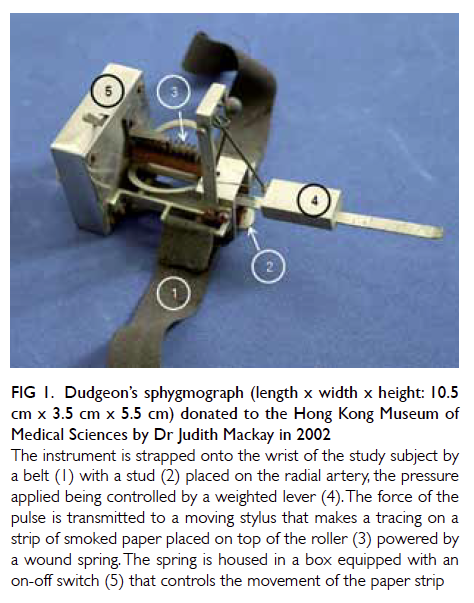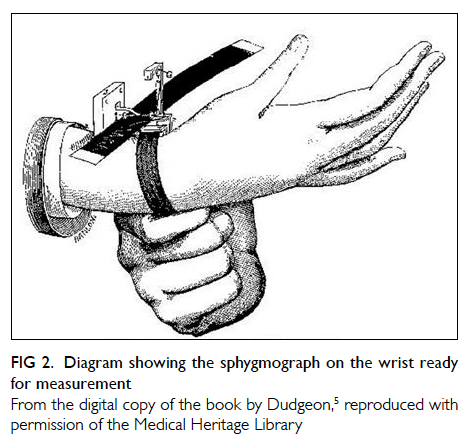© Hong Kong Academy of Medicine. CC BY-NC-ND 4.0
REMINISCENCE: ARTEFACTS FROM THE HONG KONG MUSEUM OF MEDICAL SCIENCES
The sphygmograph
CP Lau, MD, FRCP
Director, Hong Kong Museum of Medical Sciences Society
The name sounds familiar? But not quite! We all
know the sphygmomanometer for measuring blood
pressure. The key to determine blood pressure is to
measure a pulse accurately. In the 19th century, it
was not possible to do so non-invasively. Sphygmos is
the Greek word for pulse. Sphygmograph is a medical
instrument that records graphically the rise and fall
of a pulse and its rate. It was invented in 1854 by a
German physiologist Dr Karl von Vierordt (1818-1884).1 It used a system of levers to amplify the radial pulse. By compressing the radial artery proximally
using quantified weights, the disappearance of
the pulse allowed the systolic blood pressure to be
determined. In 1863, Dr Étienne-Jules Marey (1830-1904) made the sphygmograph portable, and used
the elastic force of a spring rather than the static
force of weights, and also recorded the trace on
paper. Dr Marey, a French scientist and physiologist
working in Paris, contributed significantly to
cardiology and physical instrumentation, and was
a pioneer in photography. Later, Dr Heinrich von
Recklinghausen (1867-1942), a German physician
and scientist from Wurzburg, introduced the first
practical sphygmomanometer. Incidentally, he was
the son of Dr Friedrich Daniel von Recklinghausen
(1833-1910), a German pathologist who was
associated with two eponymic diseases: multiple
neurofibromatosis (1882) and osteitis fibrosa cystica
(1891).
The sphygmograph allowed the mechanical
aspect of cardiac contraction and relaxation to be
indirectly studied. In 1871, Dr Alfred Henry Garrod
from St John’s College, Cambridge, UK, presented
a treatise on the radial pulse wave form, and
described sphygmosystole and sphygmodiastole,
corresponding to the cardiac systole and diastole.
He demonstrated the isometric period of heart
contraction by using the sphygmograph to determine
flow, and a simultaneous apex cardiograph to
determine the onset of mechanical systole in the
left ventricle.2 Pulse wave analysis has recently
received renewed interest as a means to generate a
corresponding central aortic waveform, from which
the aortic argumentation index and central aortic
pressure can be derived.3 These measurements
provide important information about arterial
stiffness, a marker of atherosclerosis.
Prior to the invention of electrocardiography,
the sphygmograph was the only way to study
cardiac arrhythmias. A well-known example was
the demonstration of atrial fibrillation by Dr James
Mackenzie, MD, FRS, FRCP (1853-1925) using a
simultaneous sphygmographic recording of the
pulse and jugular venous waveforms.4 He described a
patient with a continuing irregular pulse and absent
jugular ‘a’ wave using this equipment. This was the
first recording of atrial fibrillation in history. Dr
Mackenzie was a Scottish cardiologist and a pioneer
in the field of cardiac arrhythmias, and was knighted
by King George IV in 1915. The sphygmograph
in the collection of the Hong Kong Museum of
Medical Sciences is a Dudgeon’s sphygmograph
(Fig 1), a modification of the Marey sphygmograph by Dr Robert Ellis Dudgeon (1820-1904), a
Scottish physician best known for his practice of
homeopathy.5 The instrument was strapped on the
wrist, and the weight on the lever could be adjusted
to exert pressure on the radial pulse to produce a
tracing of the pulse on smoked paper (Fig 2). The device was donated to the Museum by Dr Judith
Longstaff Mackay, who in turn received it from
Dr Edward Hamilton Paterson on 26 July 1982. Dr
Mackay is well known in Hong Kong for her tireless
work on anti-smoking and tobacco control for which
she has been honoured with awards from many
parts of the world including the conferment by Hong
Kong Shue Yan University of the degree of Doctor of
Social Sciences, honoris causa, in 2015.6 Dr Paterson
(1920-2013) was a Scottish missionary doctor who
graduated from the Middlesex Medical School in
1943 and served as senior surgeon and later medical
superintendent of the Alice Ho Miu Ling Nethersole
Hospital from 1951 until his retirement in 1989.7 He
was best remembered for his foresight in establishing
the United Christian Hospital and developing the
concept of ‘hospitals without walls’ by starting, for
the first time in Hong Kong, community nursing and
training nursing practitioners. In recognition of his
contributions, he was conferred the degree of Doctor
of Social Sciences, honoris causa, by the University
of Hong Kong in 1985.8 Dr Paterson had this to say in
his covering note to Dr Mackay:
“...I have in my possession an incredibly ancient machine called a Dudgeon’s sphygmograph, which produces tracings of the radial pulse wave. It was given [to] me by my father, and I don’t know where he got it from, but I gather it was used fairly widely in the days before ECGs [sic] were invented. I can remember Samson Wright lecturing about the machine when I was a student, but not long after that time ECGs [sic] came into fairly general use, and I’m sure your MOs will never have heard of a sphygmograph.”
“...I have in my possession an incredibly ancient machine called a Dudgeon’s sphygmograph, which produces tracings of the radial pulse wave. It was given [to] me by my father, and I don’t know where he got it from, but I gather it was used fairly widely in the days before ECGs [sic] were invented. I can remember Samson Wright lecturing about the machine when I was a student, but not long after that time ECGs [sic] came into fairly general use, and I’m sure your MOs will never have heard of a sphygmograph.”

Figure 1. Dudgeon’s sphygmograph (length x width x height: 10.5 cm x 3.5 cm x 5.5 cm) donated to the Hong Kong Museum of Medical Sciences by Dr Judith Mackay in 2002
The instrument is strapped onto the wrist of the study subject by a belt (1) with a stud (2) placed on the radial artery, the pressure applied being controlled by a weighted lever (4). The force of the pulse is transmitted to a moving stylus that makes a tracing on a strip of smoked paper placed on top of the roller (3) powered by a wound spring. The spring is housed in a box equipped with an on-off switch (5) that controls the movement of the paper strip

Figure 2. Diagram showing the sphygmograph on the wrist ready for measurement
From the digital copy of the book by Dudgeon,5 reproduced with permission of the Medical Heritage Library
Dr Samson Wright (1899-1956) was an
eminent British physiologist who wrote the world
famous textbook Samson Wright’s Applied
Physiology. Without an instrument to measure
blood pressure non-invasively and reproducibly,
the association of hypertension with stroke and
heart diseases would not have been recognised nor
treatment of hypertension possible. These all started
from the humble beginnings of the sphygmograph.
This instrument, on its own, is well worth a visit to
the Museum.
On a personal note, when I examined the
instrument, to my surprise, the roller sprang to life
when I wound the spring, after over 100 years since
it was made!
References
1. Sphygmograph. Available from: https://en.wikipedia.org/wiki/Sphygmograph. Accessed Feb 2016.
2. Lawrence C. Alfred Henry Garrod and the indirect measurement of the isometric period of the heart’s contraction. Med Hist 1980;24:342-6. Crossref
3. Lau EO, Tse HF, Chan RH, et al. Prediction of aortic augmentation index using radial pulse transmission-wave analysis. J Hypertens 2006;24:723-30. Crossref
4. Mackenzie J. New methods of studying affections of the heart. Br Med J 1905;1:812-5. Crossref
5. Dudgeon RE. The sphygmograph: its history and use as an aid to diagnosis in ordinary practice. London: Bailliere, Tindall, & Cox; 1882. Available from: https://archive.org/details/sphygmographitsh00dudg. Accessed Mar 2016.
6. Judith Mackay. Available from: https://en.wikipedia.org/wiki/Judith_Mackay. Accessed Mar 2016.
7. The thanksgiving service for the lives of Dr. and Mrs. Edward Hamilton Paterson. Hong Kong: Alice Ho Miu Ling Nethersole Charity Foundation; 2013. Available from: http://www.nethersole.org.hk/uploaded/Booklet_Eng.pdf.
Accessed Feb 2016.
8. Citations. 124th Congregation (1985). Edward Hamilton Paterson. Available from: http://www4.hku.hk/hongrads/index.php/archive/citation_detail/243. Accessed Feb 2016.

